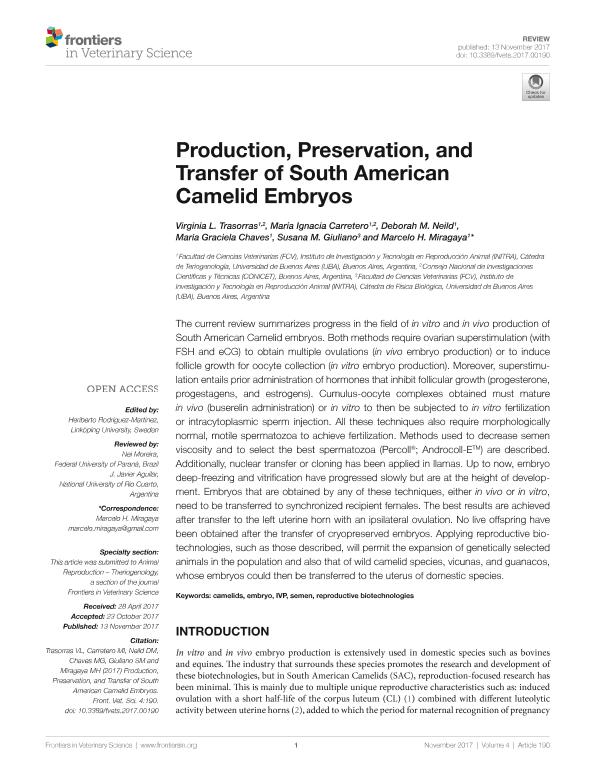Artículo
Production, preservation, and transfer of South American Camelid embryos
Trasorras, Virginia Luz ; Carretero, Maria Ignacia
; Carretero, Maria Ignacia ; Neild, Deborah M.; Chaves, María Graciela; Giuliano, Susana M.; Miragaya, Marcelo
; Neild, Deborah M.; Chaves, María Graciela; Giuliano, Susana M.; Miragaya, Marcelo
 ; Carretero, Maria Ignacia
; Carretero, Maria Ignacia ; Neild, Deborah M.; Chaves, María Graciela; Giuliano, Susana M.; Miragaya, Marcelo
; Neild, Deborah M.; Chaves, María Graciela; Giuliano, Susana M.; Miragaya, Marcelo
Fecha de publicación:
11/2017
Editorial:
Frontiers Research Foundation
Revista:
Frontiers in Veterinary Science
e-ISSN:
2297-1769
Idioma:
Inglés
Tipo de recurso:
Artículo publicado
Clasificación temática:
Resumen
The current review summarizes progress in the field of in vitro and in vivo production of South American Camelid embryos. Both methods require ovarian superstimulation (with FSH and eCG) to obtain multiple ovulations (in vivo embryo production) or to induce follicle growth for oocyte collection (in vitro embryo production). Moreover, superstimulation entails prior administration of hormones that inhibit follicular growth (progesterone, progestagens, and estrogens). Cumulus-oocyte complexes obtained must mature in vivo (buserelin administration) or in vitro to then be subjected to in vitro fertilization or intracytoplasmic sperm injection. All these techniques also require morphologically normal, motile spermatozoa to achieve fertilization. Methods used to decrease semen viscosity and to select the best spermatozoa (Percoll®; Androcoll-E™) are described. Additionally, nuclear transfer or cloning has been applied in llamas. Up to now, embryo deep-freezing and vitrification have progressed slowly but are at the height of development. Embryos that are obtained by any of these techniques, either in vivo or in vitro, need to be transferred to synchronized recipient females. The best results are achieved after transfer to the left uterine horn with an ipsilateral ovulation. No live offspring have been obtained after the transfer of cryopreserved embryos. Applying reproductive biotechnologies, such as those described, will permit the expansion of genetically selected animals in the population and also that of wild camelid species, vicunas, and guanacos, whose embryos could then be transferred to the uterus of domestic species.
Palabras clave:
Camelids
,
Embryo
,
Ivp
,
Reproductive Biotechnologies
,
Semen
Archivos asociados
Licencia
Identificadores
Colecciones
Articulos(OCA PQUE. CENTENARIO)
Articulos de OFICINA DE COORDINACION ADMINISTRATIVA PQUE. CENTENARIO
Articulos de OFICINA DE COORDINACION ADMINISTRATIVA PQUE. CENTENARIO
Citación
Trasorras, Virginia Luz; Carretero, Maria Ignacia; Neild, Deborah M.; Chaves, María Graciela; Giuliano, Susana M.; et al.; Production, preservation, and transfer of South American Camelid embryos; Frontiers Research Foundation; Frontiers in Veterinary Science; 4; NOV; 11-2017; 1-14
Compartir
Altmétricas



